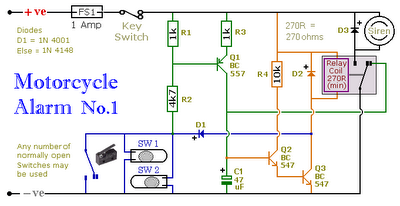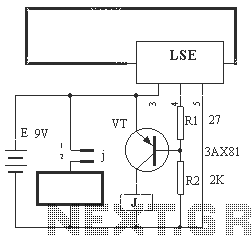
Motorcycle Alarm

This alarm can be easily adapted for a 6-volt system, making it suitable for protecting classic bikes. With a standby current of zero, it will not drain the battery. The alarm features a timed siren output and automatic reset. It can be manually operated using a key switch or a hidden switch. Additionally, by adding an external relay, the alarm will automatically set itself each time the ignition is turned off. Although it is designed for 12-volt systems, it can be modified for 6-volt applications. Various normally-open switches can be integrated, such as mercury switches that close when the steering is moved or when the bike is lifted off its side stand. Micro-switches can be used to secure removable panels and pannier lids. The siren will sound as long as at least one switch remains closed. The alarm will reset approximately two minutes after all switches have been opened, with the reset time adjustable by changing the value of capacitor C1. It is crucial to install a 1-amp in-line fuse as close as possible to the power source for wiring protection. Both the circuit board and switches must be safeguarded from moisture to prevent malfunctions. The circuit board is compact, allowing for integration into a siren with sufficient internal space. Instead of a key switch, a hidden switch or normally-closed contacts of a small relay can be utilized. Wiring the relay coil to be energized while the ignition is on will enable the alarm to set itself when the ignition is turned off. If the alarm is activated with a closed switch, the siren will sound, which can be problematic during nighttime. A modification can be made to monitor the state of the switches using LEDs; when all LEDs are off, it indicates that the switches are open and safe to activate the alarm. In standby mode, the circuit consumes minimal current, making it versatile for other applications, such as being powered by dry batteries. The low standby current and automatic reset feature may eliminate the need for an external on/off switch. Support materials for this circuit include a simulation, detailed circuit description, parts list, step-by-step construction guide, and testing instructions.
This alarm circuit is designed to provide reliable security for classic bikes by utilizing a low-power, adaptable design. The core of the system is a microcontroller that manages the various input switches and controls the siren output. The circuit includes a power supply section capable of handling both 6-volt and 12-volt systems, with voltage regulators to ensure stable operation.
The input section can accommodate multiple normally-open switches, which can be strategically placed to detect unauthorized movement or tampering. For example, mercury switches can be positioned to activate when the bike is tilted or moved, while micro-switches can be installed on removable components such as saddlebags or panels. This combination of sensors enhances the overall security of the bike by providing multiple points of detection.
The alarm's siren output is designed to emit a loud sound when triggered, deterring potential thieves. The timed output feature allows the siren to sound for a predetermined duration before automatically resetting, minimizing the risk of disturbance to nearby residents. The reset time can be fine-tuned by adjusting the capacitance of C1, allowing customization based on user preferences.
The inclusion of a 1-amp in-line fuse is a critical safety feature, protecting the wiring from potential overcurrent situations. It is essential to install this fuse as close to the power source as possible to maximize its effectiveness. Furthermore, the circuit board and switches should be enclosed in a weather-resistant housing to protect against moisture and environmental factors that could lead to circuit failure.
For ease of use, the alarm can be activated or deactivated using either a key switch or a hidden switch, providing flexibility in installation. The option to utilize a relay for automatic setting when the ignition is turned off adds an additional layer of convenience, ensuring that the alarm is always ready to protect the bike.
The monitoring feature using LEDs is a valuable addition, allowing users to visually confirm the status of the switches before activating the alarm. This reduces the likelihood of false alarms and enhances user confidence in the system.
Overall, this alarm circuit is a robust solution for securing classic bikes, offering adaptability, low power consumption, and ease of use while ensuring reliable operation in various conditions. The comprehensive support materials provided facilitate successful implementation and testing of the system.This alarm is easily adapted for a 6-volt system. So it will protect your "Classic Bike". And - because the standby current is zero - it won`t drain your battery. The alarm`s features include a timed siren output - and automatic reset. It can be operated manually using a key-switch - or a hidden switch. But - if you add an external relay - it will set itself automatically - every time you turn the ignition off. Although designed to work at 12-volts - this alarm is easily adapted for a 6-volt system. So it will protect your "Classic Bike". And - because the standby current is zero - it won`t drain your battery. The alarm`s features include a timed siren output - and automatic reset. It can be operated manually using a key-switch - or a hidden switch. But - if you add an external relay - it will set itself automatically - every time you turn the ignition off.
Any number of normally-open switches may be used. Fit the mercury switches so that they close when the steering is moved - or when the bike is lifted off its side-stand - or pushed forward off its centre-stand. Use micro-switches to protect removable panels and the lids of panniers etc. While at least one switch remains closed - the siren will sound. About two minutes after all the switches have been opened again - the alarm will reset. How long it takes to switch off depends on the characteristics of the actual components used. But - up to a point - you can adjust the time to suit your requirements by changing the value of C1 Fit the 1-amp in-line fuse as close as possible to your power source.
This is VERY IMPORTANT. The fuse is there to protect the wiring - not the circuit board. Both the board and switches must be protected from the elements. Dampness or condensation will cause malfunction. Without the terminal blocks - the board is small. Ideally, you should try to find a siren with enough spare space inside to accommodate it. Instead of using a key-switch you can use a hidden switch - or you could use the normally-closed contacts of a small relay. Wire the relay coil so that it`s energized while the ignition is on. Then - every time you turn the ignition off - the alarm will set itself. When you set the alarm - if one of the switches is closed - the siren will sound. This could cause annoyance late at night. A small modification will allow you to Monitor The State Of The Switches using LEDs. When the LEDs are all off - the switches are all open - and it`s safe to turn the alarm on. In standby mode - the circuit uses virtually no current. This should make it useful in other circumstances. For example, powered by dry batteries - and with the relay and siren voltages to suit - it could be fitted inside a computer or anything else that`s in danger of being picked up and carried away.
The low standby current and automatic reset means that for this sort of application an external on/off switch may not be necessary. The Support Material for this circuit includes a simulation - a detailed circuit description - a parts list - a step-by-step guide to construction - and details of How To Test Your Finished Alarm.
Be the first of your friends to get free diy electronics projects, circuits diagrams, hacks, mods, gadgets & gizmo automatically each time we publish. Your email address & privacy are safe with us ! 🔗 External reference
This alarm circuit is designed to provide reliable security for classic bikes by utilizing a low-power, adaptable design. The core of the system is a microcontroller that manages the various input switches and controls the siren output. The circuit includes a power supply section capable of handling both 6-volt and 12-volt systems, with voltage regulators to ensure stable operation.
The input section can accommodate multiple normally-open switches, which can be strategically placed to detect unauthorized movement or tampering. For example, mercury switches can be positioned to activate when the bike is tilted or moved, while micro-switches can be installed on removable components such as saddlebags or panels. This combination of sensors enhances the overall security of the bike by providing multiple points of detection.
The alarm's siren output is designed to emit a loud sound when triggered, deterring potential thieves. The timed output feature allows the siren to sound for a predetermined duration before automatically resetting, minimizing the risk of disturbance to nearby residents. The reset time can be fine-tuned by adjusting the capacitance of C1, allowing customization based on user preferences.
The inclusion of a 1-amp in-line fuse is a critical safety feature, protecting the wiring from potential overcurrent situations. It is essential to install this fuse as close to the power source as possible to maximize its effectiveness. Furthermore, the circuit board and switches should be enclosed in a weather-resistant housing to protect against moisture and environmental factors that could lead to circuit failure.
For ease of use, the alarm can be activated or deactivated using either a key switch or a hidden switch, providing flexibility in installation. The option to utilize a relay for automatic setting when the ignition is turned off adds an additional layer of convenience, ensuring that the alarm is always ready to protect the bike.
The monitoring feature using LEDs is a valuable addition, allowing users to visually confirm the status of the switches before activating the alarm. This reduces the likelihood of false alarms and enhances user confidence in the system.
Overall, this alarm circuit is a robust solution for securing classic bikes, offering adaptability, low power consumption, and ease of use while ensuring reliable operation in various conditions. The comprehensive support materials provided facilitate successful implementation and testing of the system.This alarm is easily adapted for a 6-volt system. So it will protect your "Classic Bike". And - because the standby current is zero - it won`t drain your battery. The alarm`s features include a timed siren output - and automatic reset. It can be operated manually using a key-switch - or a hidden switch. But - if you add an external relay - it will set itself automatically - every time you turn the ignition off. Although designed to work at 12-volts - this alarm is easily adapted for a 6-volt system. So it will protect your "Classic Bike". And - because the standby current is zero - it won`t drain your battery. The alarm`s features include a timed siren output - and automatic reset. It can be operated manually using a key-switch - or a hidden switch. But - if you add an external relay - it will set itself automatically - every time you turn the ignition off.
Any number of normally-open switches may be used. Fit the mercury switches so that they close when the steering is moved - or when the bike is lifted off its side-stand - or pushed forward off its centre-stand. Use micro-switches to protect removable panels and the lids of panniers etc. While at least one switch remains closed - the siren will sound. About two minutes after all the switches have been opened again - the alarm will reset. How long it takes to switch off depends on the characteristics of the actual components used. But - up to a point - you can adjust the time to suit your requirements by changing the value of C1 Fit the 1-amp in-line fuse as close as possible to your power source.
This is VERY IMPORTANT. The fuse is there to protect the wiring - not the circuit board. Both the board and switches must be protected from the elements. Dampness or condensation will cause malfunction. Without the terminal blocks - the board is small. Ideally, you should try to find a siren with enough spare space inside to accommodate it. Instead of using a key-switch you can use a hidden switch - or you could use the normally-closed contacts of a small relay. Wire the relay coil so that it`s energized while the ignition is on. Then - every time you turn the ignition off - the alarm will set itself. When you set the alarm - if one of the switches is closed - the siren will sound. This could cause annoyance late at night. A small modification will allow you to Monitor The State Of The Switches using LEDs. When the LEDs are all off - the switches are all open - and it`s safe to turn the alarm on. In standby mode - the circuit uses virtually no current. This should make it useful in other circumstances. For example, powered by dry batteries - and with the relay and siren voltages to suit - it could be fitted inside a computer or anything else that`s in danger of being picked up and carried away.
The low standby current and automatic reset means that for this sort of application an external on/off switch may not be necessary. The Support Material for this circuit includes a simulation - a detailed circuit description - a parts list - a step-by-step guide to construction - and details of How To Test Your Finished Alarm.
Be the first of your friends to get free diy electronics projects, circuits diagrams, hacks, mods, gadgets & gizmo automatically each time we publish. Your email address & privacy are safe with us ! 🔗 External reference





